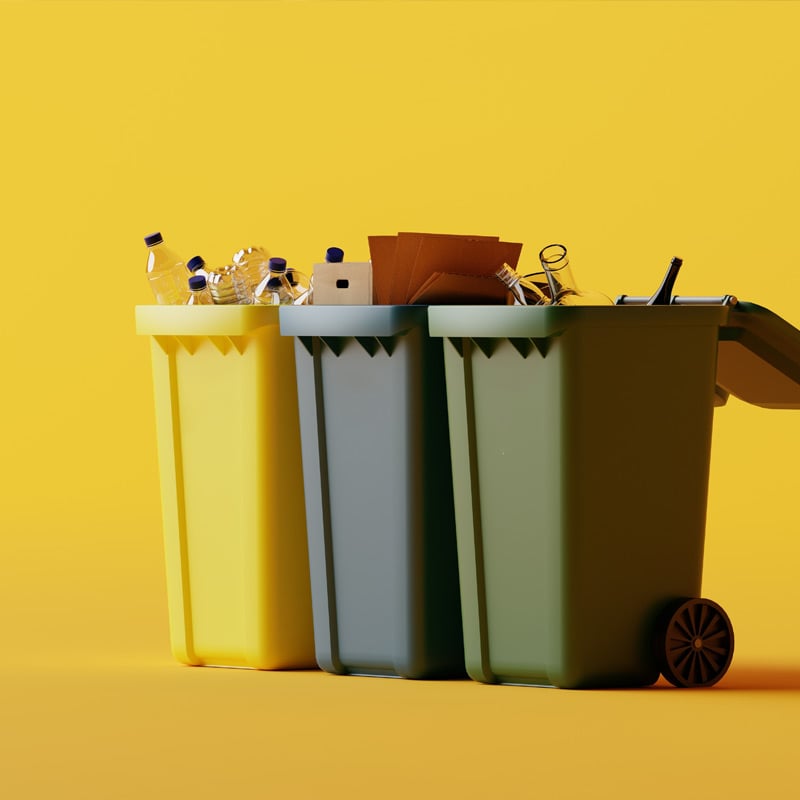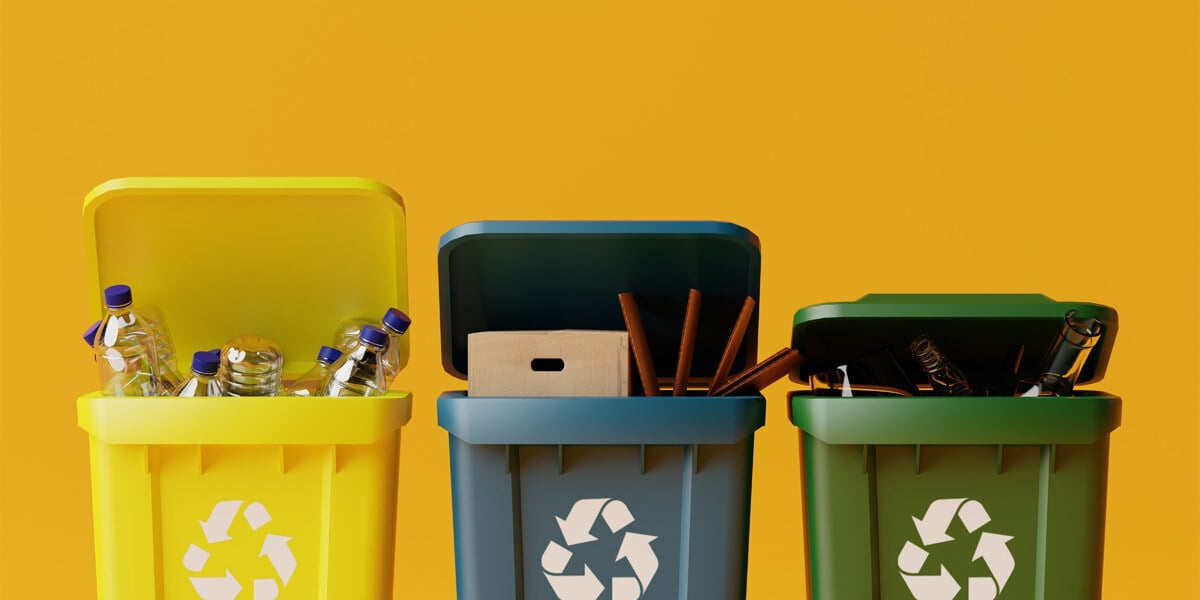As part of the Green New Deal, Europe is aiming for a circular economy by 2050. We think acceleration is necessary and aim for 2040 with our vision. An ambitious, but necessary goal to transform our world. Imagine a world where every kilo of waste finds its way back into the cycle and the term 'residual waste' has become obsolete. This is not a utopia, but an achievable reality that we can work towards together. In this blog, we take you to this dot on the horizon; a future without waste, where every action contributes to a sustainable world.
A world without residual waste
Imagine a world where we achieve a 100% separation rate of our waste. A place without residual waste bins, where every piece of waste finds its way to reuse or recycle. This scenario outlines an economy that hardly needs any primary raw materials, but thrives on secondary, reclaimed materials. What would this development mean for our economy and our planet?
Before we dive into the answer to this question, let's take a little trip into the past. A clear example of the enormous consequences of a lack of waste management was seen in urban areas during the industrial revolution. The handling of waste at that time could hardly be called conscious, resulting in major negative consequences for the environment and public health.
Global Waste Index
A situation that has improved enormously in the twentieth century, especially in countries such as the Netherlands and Belgium. These countries respectively score high on the Global Waste Index, a waste management ranking by country. The Netherlands ranks eighth with an annual waste production of 535 kg per capita, of which 224 kg is recycled. Belgium follows in 11th place with 416 kg per capita, of which 179 kg is recycled. If you compare that to the straggler, which recycles only 2 kg out of 437 kg of residual waste, the differences still appear to be large in recycling and thus separation rate.
Back to that separation percentage. The separation percentage shows the percentage of waste separated from a country, sector or company. And although the GWI positions the Netherlands and Belgium high due to their efficient waste management, the average separation percentage of 64% still shows that there is room for improvement.
100% separated waste: the new economy
Full separation would transform our economy. Companies would no longer produce residual waste, reducing their reliance on virgin new raw materials. This not only reduces costs, but also lowers the risks associated with price fluctuations and raw material shortages. And new opportunities arise. Development and innovations to efficiently separate, reuse and recycle waste streams create new jobs and production processes. And finally, there are also great ecological benefits; the shift will promote biodiversity, reduce pollution and help combat the climate crisis.
How circular is a 100 percent separation rate?
So does a 100% separation rate, which we assume in this blog, automatically mean that we reuse raw materials 100%? In this blog, we do take this as a starting point. However, practice is more complex. Waste separation is a good start, but it is only effective if the separated waste streams are processed at high quality.
Currently, a 100% separation rate unfortunately does not mean that we also recycle 100% of the raw materials. For some waste streams, high-quality recycling methods that fully retain the value of the raw materials are not yet available. In short, recycling is not possible in every case and value or quality is often lost in the process.
We will discuss the specific details of this in another blog. For now, we will stick to the ideal scenario: 100% separation leads to 100% recycling with no loss of value. This is the fully circular economy we want to achieve by 2040.
A world with 100% waste separation rate: how does this manifest itself?
Very practical: there is no more residual waste bin and all streams end up in a targeted bin for reuse or recycling. Materials consisting of multiple materials are first separated into monostreams. This can be done manually, productionally, as well as by innovative techniques such as robotization or chemical processes.
Procurement with the end phase in mind
Circularity means a different vision of procurement. Purchasing with the end phase included in the decision. After all, how long does something last and where does it end up after use? Answers to these questions will influence the buyer's decision to make the most circular choice. And where this is not possible, encourage redesign.
Redesign
This process leads to an essential shift toward redesign. It is more efficient and cost-effective to design products so that they can be easily separated and recycled, or remain reusable for long periods of time. This approach initiates a systematic change: we will value raw materials differently and integrate sustainability from the design and procurement stages.
Procurement is now limited to secondary or rapidly renewable materials, allowing buyers to become directly involved in the output of production processes. This encourages thinking in closed cycles.
Another view
This method changes our view of materials and resources. We have to work with what is available to maintain sustainable cycles, which affects our perception whether you are a buyer, sustainability manager or consumer. This is illustrated by the story of Nienke Keen, Impact Manager at Milgro, about repairing her phone.
"I have come to realize even more how valuable the resources we take from the earth are," Nienke explains. "It takes a lot of energy and labor to turn raw materials into our stuff, but often we treat them carelessly and throw them away, even before they're really broken. My experience shows that careful handling of stuff changes my bond with it. Recently, I repaired an old phone that I had written off. I managed to get it working again. This not only gave me a renewed appreciation for the phone, but strengthened my bond with the product, making me enjoy it more. And the same goes for the sweater I repaired and the cabinet I refurbished."
Import and export
Closed cycles do not mean no more imports or exports of secondary materials, but they will decrease significantly. Local reuse of raw materials offers geopolitical and logistical advantages and promotes circular economies at the local level. This leads to less transportation and more energy efficiency.
Positive eco-effects of high waste separation rate
At the same time, our perspective is shifting substantially: not only is the way we see the world changing, so is the world itself. If we use current resources efficiently, which research suggests may be adequate even with growing demand from an increasing population and prosperity, we significantly reduce the mining of non-renewable resources. This has positive effects on our world. On biodiversity, reduces pollution and increases social welfare. By using only renewable resources, we make Earth Overshoot Day obsolete.
Getting started yourself? Increase your separation rate with these steps:
- It starts with understanding waste streams. You may be thinking: I already have that insight. Yet our experience is that companies can always be surprised by the outcome of a so-called waste scan, with which we map all waste streams and improvements to them.
- A second is knowledge of waste streams. That is often really an expertise. It is not only about which streams can still be separated, but also about innovations to separate these streams. And to process them into the highest quality solution.
- Set goals. What percentage of separation do you aspire to? What does that mean in terms of savings in emissions and costs? And for laws and regulations, such as the CSRD?
Separating waste and the bigger picture
Want to get started? Then think about the bigger picture. Separating waste is a good start, but what happens after separation is just as important. After all, separating only makes sense if the waste is processed adequately afterwards. It is important to know where the separated stream goes, how it is transported, how it is processed, how much energy it takes, and whether there are reuse options. These are aspects to consider and about which you can obtain advice, for example by means of a waste scan.
And a nice afterthought: prevention is always better than cure. Preventing the waste of raw materials is always paramount. Achieving zero residual waste by properly separating everything is good, but preventing valuable raw materials from becoming waste is, as far as we are concerned, the ultimate goal.

Hulp nodig bij de eerste stap? Start met een afvalscan
U wilt het afval van uw organisatie verminderen en de overige afvalstromen beter scheiden, maar waar begint u? Een afvalscan brengt de hoeveelheid, de kosten en CO2 impact van alle afvalstromen van uw organisatie haarfijn in beeld. Na de afvalscan ontvangt u van ons een overzichtelijk rapport waarin uw potentieel in euro en eco is opgenomen.
Maak nu een vrijblijvende afspraak om de kansen voor uw organisatie te bespreken
Op de hoogte blijven
Op de hoogte blijven van alle nieuwe ontwikkelingen? Volg ons op LinkedIn en Instagram of abonneer u op de nieuwsbrief. Bent u nieuwsgierig naar wat Milgro voor uw bedrijfsvoering en afvalproces kan betekenen? Neem dan contact op.













